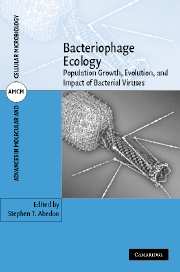Book contents
- Frontmatter
- Contents
- About the cover
- List of contributors
- Foreword by Bruce R. Levin
- Preface
- 1 Phages, ecology, evolution
- Part I Phage ecology
- Part II Phage evolutionary biology
- 6 Phage evolutionary biology
- 7 Phage evolution
- 8 Evolutionary ecology of multiple phage adsorption and infection
- 9 Patterns in phage experimental adaptation
- Part III Phage ecology in environments
- Part IV Modeling phage ecology
- Index
- Plate section
8 - Evolutionary ecology of multiple phage adsorption and infection
from Part II - Phage evolutionary biology
Published online by Cambridge University Press: 29 September 2009
- Frontmatter
- Contents
- About the cover
- List of contributors
- Foreword by Bruce R. Levin
- Preface
- 1 Phages, ecology, evolution
- Part I Phage ecology
- Part II Phage evolutionary biology
- 6 Phage evolutionary biology
- 7 Phage evolution
- 8 Evolutionary ecology of multiple phage adsorption and infection
- 9 Patterns in phage experimental adaptation
- Part III Phage ecology in environments
- Part IV Modeling phage ecology
- Index
- Plate section
Summary
INTRODUCTION
Multiple adsorption of phages to individual bacteria can lead to coinfection, which can occur with reasonable likelihood given sufficiently high phage densities. As there can be an incredible diversity of phages that infect the same host (e.g., the coliphages), coinfection between unrelated phages is also possible. This chapter begins with a discussion of phenomena associated with multiple phage adsorption, including coinfection as well as superinfection exclusion and immunity. Subsequently we consider the evolutionary ecological effects specifically of coinfection: genetic exchange via recombination, reassortment, complementation between phages, phenotypic mixing, and within-host competition. Finally, we highlight research with the RNA phage ø6 to illustrate the long-term effects of coinfection on the evolution of phage genes, genomes, individual phages, phage populations, and communities.
Evolutionary ecology of phage—phage interaction
Evolutionary ecology sits at the interface of ecology and evolutionary biology. In considering how organisms have evolved to become adapted to their environments, it examines the selective pressures imposed by the environment and the evolutionary response to these pressures (Pianka, 1999). From a purely evolutionary standpoint, a lytic phage's main goal is to successfully harness the host cell's machinery to make progeny. These offspring determine the growth capacity (fitness) of the virus relative to other genetic variants in the population.
- Type
- Chapter
- Information
- Bacteriophage EcologyPopulation Growth, Evolution, and Impact of Bacterial Viruses, pp. 195 - 216Publisher: Cambridge University PressPrint publication year: 2008
- 11
- Cited by



